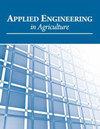海参沙门氏菌射频净化技术的研究进展
IF 0.9
4区 农林科学
Q4 AGRICULTURAL ENGINEERING
引用次数: 0
摘要
接种鸡尾酒沙门氏菌和粪肠杆菌后,草草样品的初始微生物负荷分别为7.81和7.75 log CFU/g。经过165、175、185和195 s的射频处理,195 s完全去污后,沙门氏菌的负荷分别降至5.80 (SD±0.24)、4.00 (SD±0.27)、1.42 (SD±2.01)log CFU/g。在射频处理165和175 s时,粪肠杆菌负荷分别降至7.50 (SD±0.14)和6.39 (SD±0.31)log CFU/g,在185和195 s完全去污。铁、维生素A或氨基酸的反应没有统计学上的显著变化;由于射频治疗时间延长,钠水平升高,钾和钙水平降低。摘要本研究的目的是:1)研究射频加热对提摩西干草中肠炎沙门氏菌和粪肠球菌NRRL B-2354的去除效果;2)在射频处理期间,评价粪肠杆菌作为timothyhay中沙门氏菌替代品的适宜性;3)评价射频处理对草干草中维生素、氨基酸、脂肪酸和微量矿物质的理化变化。采用中试并联板射频加热系统(6 kW, 27.12 MHz)进行研究。射频系统中的电极间隙调整为205 mm。蒂莫西干草从内布拉斯加州林肯市的一家宠物食品制造厂采购,初始水分含量(MC)为7%至9%(湿基)。将提摩西干草样品(150 g)接种含有五种血清型肠道沙门氏菌[Agona沙门氏菌(447967)、Mbandaka沙门氏菌(698538)、蒙得维多沙门氏菌(488275)、田纳西沙门氏菌(K4643)和Reading沙门氏菌(Moff 180418)]的鸡尾酒或粪肠球菌肉汤,然后在37℃下孵育24±2小时。提摩西干草样品在射频能量下暴露165、175、185和195 s。结果表明,接种鸡尾酒沙门氏菌和粪肠杆菌后,草草样品的初始微生物负荷分别为7.81和7.75 log CFU/g。RF处理165、175、185和195 s后,沙门氏菌负荷(mean±SD log CFU/g)分别降至5.80±0.24、4.00±0.27、1.42±2.01 log CFU/g和低于检测水平。在RF处理165和175 s时,粪肠杆菌负荷(mean±SD log CFU/g)降至7.50±0.14和6.39±0.31 log CFU/g,低于185和195 s时的检测水平。在1885年和1950年进行了完全的净化。由于RF治疗时间的延长,铁、维生素A或氨基酸的反应没有统计学上的显著变化。该研究证明了一种非化学方法可以从低水分食品(如宠物食品)中去除沙门氏菌和屎肠球菌。关键词:去污,粪肠球菌,低水分,宠物食品,射频,沙门氏菌,干草本文章由计算机程序翻译,如有差异,请以英文原文为准。
Development of a Radio-Frequency Technology for the Decontamination of Salmonella from Timothy Hay
Highlights
After inoculation with the Salmonella spp. cocktail and E. faecium, timothy hay samples had an initial microbial load of 7.81 and 7.75 log CFU/g, respectively.
After RF treatments of 165, 175, 185, and 195 s, Salmonella spp. loads were reduced to 5.80 (SD ± 0.24), 4.00 (SD ± 0.27), 1.42 (SD ± 2.01) log CFU/g with complete decontamination at 195 s.
At 165 and 175 s of RF treatments, the E. faecium loads were reduced to 7.50 (SD ± 0.14) and 6.39 (SD ± 0.31) log CFU/g with complete decontamination at 185 and 195 s.
There were no statistically significant changes in the iron, vitamin A, or amino acid responses; sodium levels increased, and potassium and calcium levels decreased due to increasing RF treatment duration.
Abstract. The objectives of this research were: 1) to investigate the efficacy of RF heating on the decontamination of Salmonella enterica and Enterococcus faecium NRRL B-2354 in timothy hay; 2) to evaluate the suitability of E. faecium as a surrogate of Salmonella in timothy hay during RF treatment; 3) to assess the physicochemical changes after RF treatment on vitamins, amino acids, fatty acids, and trace minerals in the timothy hay. A pilot-scale parallel-plate RF heating system (6 kW, 27.12 MHz) was used to conduct this study. The electrode gap in the RF system was adjusted to 205 mm. Timothy hay was procured from a pet food manufacturing plant in Lincoln, Nebraska, at an initial moisture content (MC) of 7% to 9% (wet basis). Timothy hay samples (150 g) were inoculated with either a cocktail containing five serotypes of Salmonella enterica [Salmonella Agona (447967), Salmonella Mbandaka (698538), Salmonella Montevideo (488275), Salmonella Tennessee (K4643), and Salmonella Reading (Moff 180418)] or a broth of Enterococcus faecium then incubated at 37°C for 24 ± 2 h. Timothy hay samples were exposed to RF energy for 165, 175, 185, and 195 s. It was determined that after inoculation with the Salmonella cocktail and E. faecium, timothy hay samples had an initial microbial load of 7.81 and 7.75 log CFU/g, respectively. After RF treatments of 165, 175, 185, and 195 s, Salmonella loads (mean ± SD log CFU/g) were reduced to 5.80 ± 0.24, 4.00 ± 0.27, 1.42 ± 2.01 log CFU/g and below the level of detection, respectively. At 165 and 175 s of RF treatments, the E. faecium loads (mean ± SD log CFU/g) were reduced to 7.50 ± 0.14 and 6.39 ± 0.31 log CFU/g and below the detection level at 185 and 195 s. There was complete decontamination at 185 and 195 s. There were no statistically significant changes in the iron, vitamin A, or amino acid responses because of increasing RF treatment duration. The study demonstrated a non-chemical approach to decontaminating Salmonella and Enterococcus faecium from low-moisture foods such as pet foods. Keywords: Decontamination, Enterococcus faecium, Low moisture, Pet food, Radio-frequency, Salmonella, Timothy hay.
求助全文
通过发布文献求助,成功后即可免费获取论文全文。
去求助
来源期刊

Applied Engineering in Agriculture
农林科学-农业工程
CiteScore
1.80
自引率
11.10%
发文量
69
审稿时长
6 months
期刊介绍:
This peer-reviewed journal publishes applications of engineering and technology research that address agricultural, food, and biological systems problems. Submissions must include results of practical experiences, tests, or trials presented in a manner and style that will allow easy adaptation by others; results of reviews or studies of installations or applications with substantially new or significant information not readily available in other refereed publications; or a description of successful methods of techniques of education, outreach, or technology transfer.
 求助内容:
求助内容: 应助结果提醒方式:
应助结果提醒方式:


